Einstein's Bern, Birthplace of E = mc 2
Einstein spent seven years in Bern (1902 - 1909) while working for the Swiss patent office. Bern is the capital city of Switzerland, and there are many things to see. However, we are mainly interested in how this city is proud of Einstein and his formulation of the theory of relativity.
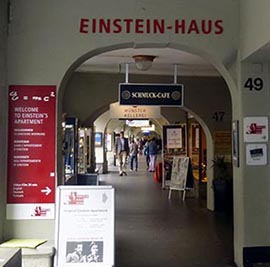
|
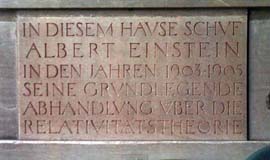
|
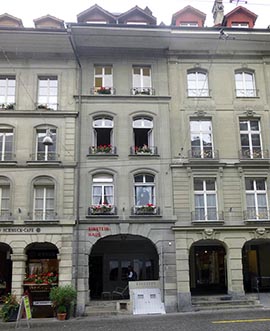
|
- Einstein's apartment commonly called "Einsteinhaus" is located on the
street called Kramgasse in Bern. As can be seen
from this photo, the walkways along this street are covered, and you
will see the sign "Einsteinhaus" when you approach this Haus.
- This is the sign you see while
you walk toward the Einsteinhaus.
- When I went there in 1999, I took a photo of
the plate saying in German that
Albert Einstein in 1905 formulated the concept of relativity theory
in this house.
- When I was there in 2014, this plate was
still there.
- In 1999, I took these photos of the
items in front of the entrance. The entrance to the apartment was
locked without any sign, and the ground floor was used for a restaurant
called "zum Untern Junker."
-
These two photos show the Einsteinhaus
looked in 1999 and 2014 from across the street. The change took place
in 2005, the E = mc2 Centennial Year. It is safe to assume
that the city of Bern purchased the whole building and converted into a
museum called "Einsteinhaus."
- The street in front of the Einsteinhaus is called Kramgasse. I was there in 1999, and this is a photo of myself standing there. The city's clock tower is seen in both photos. This street has its history.
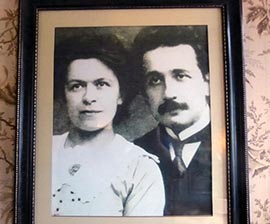
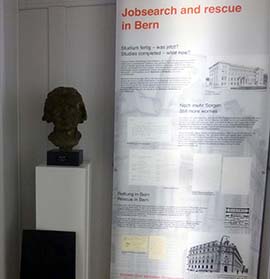
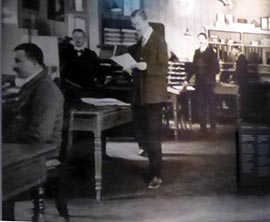
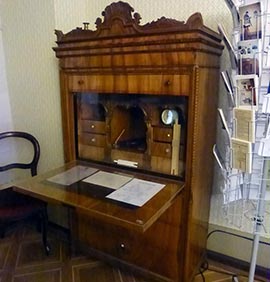
- This is the sign you see while
you walk toward the Einsteinhaus.
- In 1903, Einstein came to Bern to work for the Swiss Patent Office
as a research assistant after spending frustrating years since his
graduation in 1900 from the
ETH in Zurich. In the same year, before coming to Bern,
Einstein married Mileva Maric
who was his classmate at the ETH.
Their apartment was on the third floor (2nd floor according to European counting) of this building. This space is now used as one of the two museums in Bern dedicated to known today as the Einsteinhaus. Einstein. Photos are allowed but videos are not. I can share with you some photos taken there.
- Einstein's parents. Einstein
was born in
Ulm, Germany.
- Einstein's Genealogy, as complicated as yours.
- Einstein's passport pages. Before coming to the United States, Einstein travelled from Germany to many different countries including Italy, Switzerland, Czechoslovakia, Japan.
- This wall poster gives a brief description of Einstein's life in Bern (1902-09).
- This photo shows that it was not easy for Einstein to find a job at his time. He had to settle down with a position at the Swiss patent office in Bern. The patent office looked like this.
- This is a photo of Einstein working in at the patent office. He looks quite hopeless. This photo is from the Einstein Museum (not from the Einsteinhaus).
- Einstein was a music lover. Like Einstein, many physicists like music. Click here for a music page for physicists.
- This is the desk Einstein used to write his articles on relativity.
- Before coming to Bern, Einstein studied at the ETH in Zurich. After spending seven years in Bern, he went back to Zurich as a professor. He then went to Berlin.
- This photo shows where Einstein was since 1914, and major events that affected his life. The major events include Einstein's new love in 1919, Nobel prize in 1921, and immigration to the United States in 1933.
- Einstein's Genealogy, as complicated as yours.
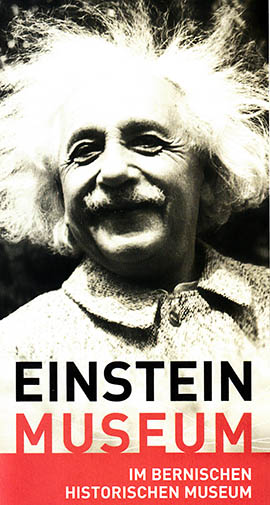
is a high-tech museum. 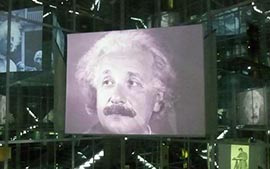
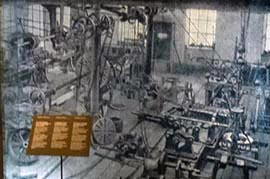
- Einstein's parents. Einstein
was born in
Ulm, Germany.
- The Einstein Museum is located about one km south of the Einsteinhaus
(within a walking distance). The Museum is housed in an old
Swiss-style building for the Historical Museum of Bern. The Einstein
Section was refurbished to meet modern high-tech standards. Let us
look at some photos I took there.
- It is not difficult to find where the Einstein Museum is
Look at this sign along the
road leading to the Museum.
- The Museum is in a Swiss-style museum
building. This building was built originally for the Historical
Museum of Bern.
- The Einstein Museum in this building was designed to meet
the high-tech age.
This is another photo
telling how elegant the museum arrangements are.
- Einstein was born in Ulm in 1979, but his family moved to Munich
when he was less than one-year old. In Munich, the Einstein family
ran a very profitable electric appliance factory with up to
200 employes. This is
a photo of the factory. In Munich, Einstein family enjoyed
a affluent life.
- This is a replica of the
family dinner table.
- The typewriter and the telephone and owned by the family.
- Einstein went to his school in Munich. This is one of his class photos.
- This is a replica of the
family dinner table.
- Alas in 1894, the family company became bankrupt. While
their factory was producing DC-based electrical appliances,
the AC revolution put those DC factories out of business.
Thus, when Einstein was 15 years old,
he had to go to Italy
with his parents. They first moved to Milan, and then
Pavia.
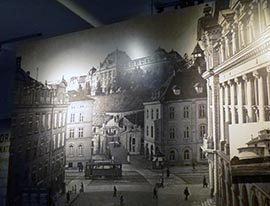
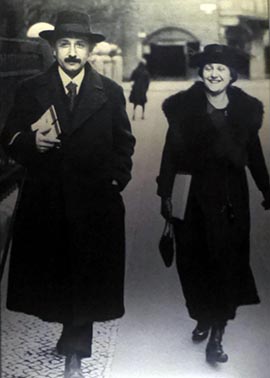
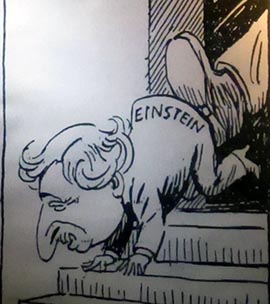
- One year later, when Einstein was 16 years old,
he came to Switzerland to attend the
ETH. He received his diploma in 1900 and acquired Swiss
citizenship in 1901. The city of Zurich
looked like this while Einstein was a student there.
The ETH is at the top of the hill.
- In 1903,
Einstein married Mileva Maric who was his classmate
at the ETH, and managed to find a job after spending frustrating
years after graduation. He became a research assistant at the
Swiss Patent Office in Bern, and stayed there until 1909. He went
back to the ETH as a professor. He then went to Berlin in 1912,
while Mileva stayed in Zurich.
- While in Berlin in 1919, after a prolonged separation from
Mileva, Einstein found a new love and
married Elsa Lowenthal, after divorcing his first wife. Elsa
came to the United States with Einstein in 1933, but died in
1936.
- There are many more interesting photos and stories to fill in
about Einstein's life until he was
exiled to Princeton in 1933.
I will post them when I have time. Even better. Go to Bern and visit the musuems without relying on this webpage.
However, I cannot leave out photos of Einstein's Nobel Prize items from the Museum. Here is a photo certificate and citation. This is a photo of the citation and the Nobel medal. He received this prize in 1921 for his work on photo-electric effect leading to the concept of wave-particle duality, not for relativity.
- In 1933, Einstein moved to the United States. The reason for
this move is well known. After he left Europe, anti-Semitic
European newspapers printed this
cartoon.
- It is not difficult to find where the Einstein Museum is
Look at this sign along the
road leading to the Museum.
- Even in the United States, the established universities were
reluctant to offer a permanent position to Einstein because of
his Jewish background. Princeton was nice enough to offer him
a position at the Institute for Advanced Study, and he became
the first Jewish resident in this small university town.
- While in Princeton, he did not meet too many people. He had
his house on Mercer street,
but he lived in total isolation. I assume this is the reason
why he became so popular. If you talk too much to news media,
you are likely to get negative reactions, and negative opinions
are always stronger than positive opinions. Princeton
treated him nicely.
- Furthermore, Einstein used to make mistakes in his income tax
returns, but tax authorities did not raise the issues. This
is the privilege not given even to the president of the United
States.
He became a a citizen of the United States in 1940. Here is a photo of his citizenship certificate shown at Bern's Einstein museum. The person in the middle of this photo was a member of the band at the New Jersey courthouse where the citizenship ceremony took place. He told me Einstein was an old man there.
- Due to Einstein's God-like image, every physics graduate wanted
to go to Princeton University
for his graduate study. Princeton was an all-male school at
that time. They did not know or pretended not to know Einstein's
Institute was different from the University.
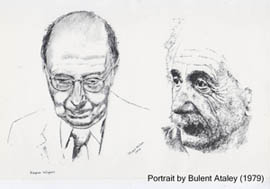
- This culture continued for many years after Einstein died in 1955,
and I am one of them who went to Princeton in 1958 for my graduate
study. I did not meet Einstein, but I met some people who met
Einstein. Eugene Wigner met Einstein in Germany and met again
in Princeton. You may
click here to see my connection with Wigner on Einstein issues.
I also met the person who used to photograph Einstein. He also took my photo in 1961, the day before my PhD commencement. Click here if you are curious.
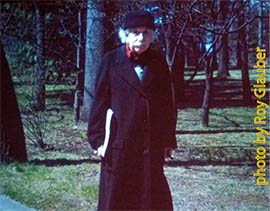
-
Roy Glauber was at Einstein's Advanced Institute during Einstein's
final years. Glauber is, during his conference talks, quite fond of
showing the photos of Einstein he took with his own camera.
This is a photo of Einstein giving
his last lecture at Princeton
University. This is a
color photo of Einstein walking to his house from the Institute.
- Christmas Morning at Einstein's House.
In Princeton, there is a small college called Westminster Choir
College. The student choir of this college used sing Christmas carols
in front of Einstein's house to tell Einstein the Christ has come.
- Scientifically speaking, was the United States ready for Einstein?
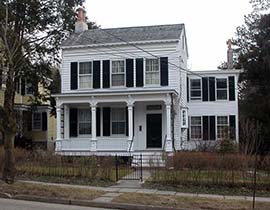
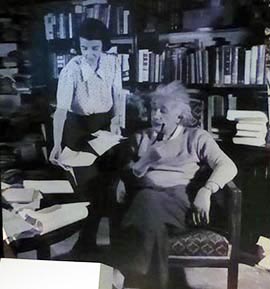
This photo is from Bern's Einstein
Museum. - While in Princeton, he did not meet too many people. He had
his house on Mercer street,
but he lived in total isolation. I assume this is the reason
why he became so popular. If you talk too much to news media,
you are likely to get negative reactions, and negative opinions
are always stronger than positive opinions. Princeton
treated him nicely.
- Let us go back to to the Einstein Museum in Bern. I was able to see
the following interesting items.
- Time Magazine covers
carrying Einstein's images.
- Image of Einstein together
with that of Marilyn Monroe, as two of the most popular
Americans during the period 1950-55,
- together with Elizabeth Taylor
and Marlon Brando.
- These were the
convenience items developed by Americans during the same
period. I came to the United States in 1954 from Korea. I
became fascinated with those gadgets.
- On April 18, 1955, when I was in my dormitory room between the
classes, I heard the news from my vacuum-tube radio that Einstein
died. I was a freshman at the Carnegie Institute of Technology in
Pittsburgh.
On March 12, 1958, I got a letter from Princeton University that I was one of the 15 boys accepted to the graduate program in physics. It was the happiest day in my life. I now maintain webpages both for Carnegie Tech , and for Princeton University.
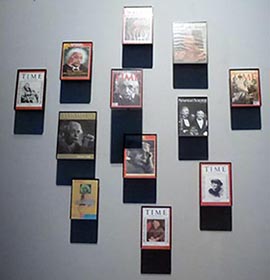
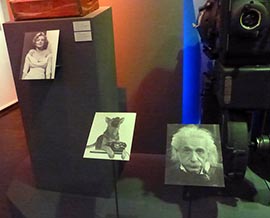
- Time Magazine covers
carrying Einstein's images.
- I indeed learned many lessons from those two museums in Bern. For instance,
I did not know before why Einstein had to go to Italy when he was 15 years
old. I have the following two comments.

- From the Museum, I was expecting to learn more about Einstein's philosophical
inclinations, but I was not able to see items along this direction.
Perhaps you can visit this page to see
why they could be common-sense museum issues these days.
- The Einstein Museum states that Einstein was totally isolated
from the physics world because he did not accept quantum mechanics.
I am in agreement agree with the Museum's view, but I have
something to add to this issue.
Is it Einstein's fault? Are you going to blame Einstein for not writing papers helium atoms or neutron-proton scattering?

Image of Heisenberg from AIP E. Segre Visual Archives (top),
and that of Yukawa and Einstein
from Maininchi Shinbun (1981.9.9).
- From the Museum, I was expecting to learn more about Einstein's philosophical
inclinations, but I was not able to see items along this direction.
Perhaps you can visit this page to see
why they could be common-sense museum issues these days.
- While the physics world was becoming a quantum world, there were
many physicists who wanted to invite Einstein back to the physics
community. I can mention the following two distinguished physicists
who visited Einstein.
- In 1954, Werner Heisenberg visited Einstein's house in Princeton
to ask Einstein to accept his uncertainty principle as a
fundamental law of physics,
but he failed to change Einstein's mind.
Click here for a detailed story.
- In 1953, Hideki Yukawa visited Einstein at the Institute for
Advanced Study. They had
this photo. They appear to be very happy.
Then, what did Yukawa tell Einstein? I do not know since I was not there, but it is not difficult to guess what happened from Yukawa's 1953 paper published in the Physical Review. Yukawa must have talked about what he wrote in this paper.
- Irene Joliet-Curie also visited Einstein. Einstein seems to be very happy in this photo.
- In 1954, Werner Heisenberg visited Einstein's house in Princeton
to ask Einstein to accept his uncertainty principle as a
fundamental law of physics,
but he failed to change Einstein's mind.
Click here for a detailed story.
- The question then is why Einstein was so unhappy with Heisenberg,
while he was happy with Yukawa. The answer is very simple.
Heisenberg was talking to him about the topic Einstein was not
interested in, while Yukawa was telling a story Einstein wanted to
hear.
- Heisenberg in
his article says he could handle the mathematics
of Lorentz transformations, but he could not understand
the physics of simultaneity. With this kind of background,
nobody could talk to Einstein. As for the simultaneity,
look at this page.
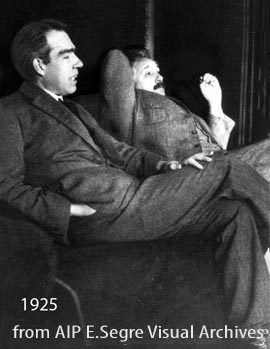
Bohr and Einstein. They must have talked about how the hydrogen atom would look to a moving observer. In order to answer this question, they needed the machine producing hydrogen atoms moving with relativistic speeds.
Click here for a detailed story.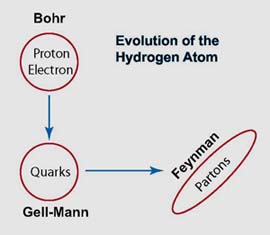
- According to
his 1953 paper, Yukawa must have talked to Einstein about how
to construct harmonic oscillator wave functions (standing waves) that
can be Lorentz-transformed.
This problem is the same as how the hydrogen wave function (standing wave) looks to a moving observer. Niels Bohr was worrying about the electron orbit of the hydrogen atom, and Einstein was worrying about how things look to moving observers. Thus, the question is how the hydrogen atom looks to a moving observer. Bohr and Einstein met frequently, and they must have discussed this problem.
In 1953, Yukawa was telling Einstein what he was discussing earlier with Bohr about bound orbits or standing waves.
- However, when Bohr and Einstein talked, the hydrogen atom
moving with a relativistic speed was unthinkable. This is still
impossible, but there are these days many protons moving with
a speed close to that of light. On the other hand, does
the same quantum mechanics apply to the proton? Click
here for the evolution of the
hydrogen atom.
- Heisenberg in
his article says he could handle the mathematics
of Lorentz transformations, but he could not understand
the physics of simultaneity. With this kind of background,
nobody could talk to Einstein. As for the simultaneity,
look at this page.
- I am not the first one to see this gap between Bohr and Einstein.
Indeed, Dirac, Wigner, and Feynman made major contributions toward
understanding this problem. I have been assembling their works
since 1970, after hearing
Feynman's talk given at the 1970 APS meeting in Washington, DC
in U.S.A. The result of my efforts is presented
in my Einstein page.
Remember this. If you are interested in building a canal, the only way is to connect the existing lakes. Dirac, Wigner, and Feyman served as the needed lakes for me. You may be interested those lakes.
Canal to where? To Einstein, of course! Click here.
Y.S.Kim (2104.10.10)
- copyright@2014 by Y. S. Kim, unless otherwise specified.
The portrait of Einstein and Wigner is by Bulent Atalay (1978).
- Click here for his home page.
- Einstein page.
- Princeton page.
- His book about Einstein.
- Style page.
- Style page.
- Click here for his home page.
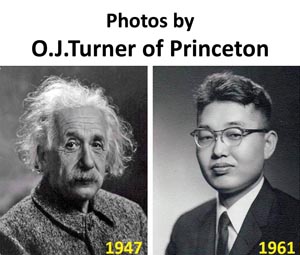
|
| Why is he with Einstein? |